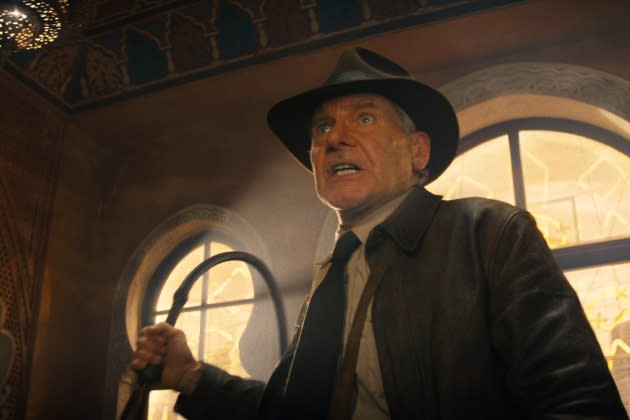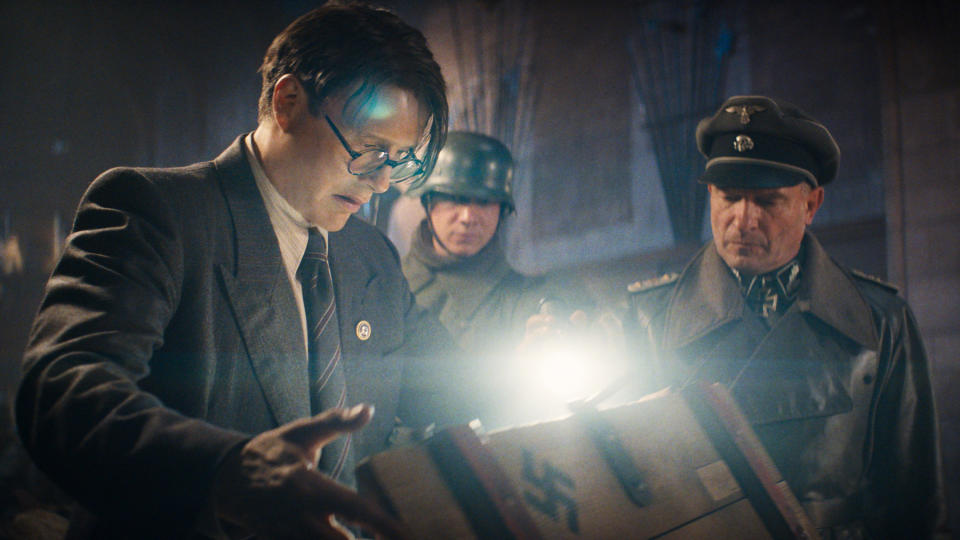‘Indiana Jones and the Dial of Destiny’ Does Harrison Ford’s Indy Dirty
- Oops!Something went wrong.Please try again later.
- Oops!Something went wrong.Please try again later.
- Oops!Something went wrong.Please try again later.

Indiana Jones has fought a lot of screen villains: Nazis, assassins, evil high priests, corrupt rich douchebags, Cate Blanchett, Cate Blanchett’s hair. Yet Indiana Jones and the Dial of Destiny — the fifth movie to feature Harrison Ford’s globetrotting, snake-hating, whip-cracking, fedora-rocking archeology professor — pits our man Indy against the single greatest nemesis he’s ever faced: time.
Oh, there’s a ton of Nazis here too, trust us. Ditto some shady government agents, a racist redneck, a henchman roughly the size and width of a redwood, a Moroccan kingpin with a scimitar, and your usual assorted thugs. But the latest chapter of Steven Spielberg’s throwback adventurer is centered around the idea that everyone, even the good guys we grew up worshiping and the movie stars who played them, can’t win the fight against the passing of the years. Doesn’t matter if you digitally de-age and deepfake them all you want — and lord knows that Dial of Destiny does, courtesy of a prologue that channels that original Indy trilogy as best as it possibly can. If we’re lucky, they simply battle it to a draw. That, and they’ve just kept themselves in such great shape that anyone would think they were half their current age. (Ford was already in his late thirties when he first slipped into the weathered leather jacket and outran a boulder. That was 1981. Do the math.)
More from Rolling Stone
'Gremlins: Secrets of the Mogwai' Is Enchanting and Terribly Cute
'Killers of the Flower Moon' Is Martin Scorsese's Great American Tragedy
Still, you either die an intellectual-property hero trapped in amber, or you live long enough to see yourself riding a fake horse against a green-screened subway background when most of your peers have slowed down. Dial of Destiny does eventually lean heavy into the concept of a beloved man of action in his autumn years, showing us an Indiana Jones who has trouble getting out of bed and yells at hippie kids to turn down their Magical Mystery Tour album. The world has moved on from the sort of swashbuckling derring-do in distant jungles and exotic lands. Who cares about ancient artifacts excavated from the earth when men have just landed on the moon?
But first, we’re whisked back to 1944. A guy in a German military uniform is being led to an interrogation room, as bombs are being dropped all over Berlin. The bag over his head is lifted, and voila! There’s Indiana Jones, looking as if he’d just watched the Ark of the Covenant take out a bunch of vintage no-goodniks mere hours before. The archeologist is after the Lance of Longinus, the spear that pierced the side of Christ and has been “liberated” by a Nazi colonel (Thomas Kretschmann) who believes it’s got magical powers. Jones clocks it as a fake; so does Professor Jürgen Voller (Mads Mikkelsen). They both know there’s something else in this batch of stolen goods that is a big deal, however: the Antikythera, a.k.a. Archimedes’ Dial. Or half of it, at least. Whoever nabs this and finds the other half may determine who wins the war.
There’s an undeniable rush to seeing the Raiders-era Jones/Ford replicated so faithfully, and done in a way that keeps skirting the edge of the uncanny valley yet never seems to plummet into it. Director James Mangold has taken over the reigns from Steven Spielberg, and he’s clearly studied the master’s playbook as if it were a holy scroll. The Logan director has coordinated a series of interlocking set pieces — featuring CGIndy escaping exploding buildings, leaping from cars onto speeding motorcycles, and running across train tops to the sound of John Williams’ iconic franchise theme — with all the precision of a massive game of Mousetrap. (The help of the editing trio of Andrew Buckland, Michael McCusker, and Dirk Westervelt to achieve this minor miracle can’t be overstated.) It’s like watching the cinematic equivalent of the world’s greatest Beatles cover band do the hits down to the last note, and is undeniably a blast. And then, like a giant boulder unleashed from its underground perch, everything rapidly rolls downhill from there.
Now it’s 1969, and Jones is being forced out to pasture by his Hunter College bosses. A young woman approaches him, asking a lot of questions about Archimedes’ Dial. She’s Helena Shaw (Phoebe Waller-Bridge), Indy’s goddaughter; her dad, Basil (Toby Jones), was with Jones when that stolen half of the dial was lost back in ’44. She thinks she’s located its current whereabouts; moreover, Helena has a good idea of where the second half is as well. Meanwhile, Voller — now going by Dr. Schmidt, and designing rockets for America, because of course — is also looking for info on the artifact. Along with C.I.A. operatives and an acolyte from Alabama (Boyd Holbrook), he’s determined to find out what Helena knows. The reason everyone is after the dial is because, once the two halves are joined, it’s no longer just a golden ancient whatsit. It’s a time machine.

Movies can be time machines too, of course, something that Spielberg and George Lucas knew all too well when they hashed out what would become Raiders of the Lost Ark during a vacation in Hawaii. They were trying to bring back the giddiness they felt as kids, watching old 1930s serials filled with cliffhangers and narrow escapes, and ended up setting the tone for 1980s blockbusters. Dial of Destiny transports viewers back to the dying days of World War II and the times-they-are-a-changin’ late Sixties (a protest against the Vietnam war becomes a plot device). But what it really wants to do is drop you right back into 1981, when seeing Harrison Ford pull himself over, under, and through a moving truck felt like you were injecting 10ccs of pure, uncut excitement right into your jugular. Mangold is chasing after a treasure just as much as Jones, Shaw and Voller are, though his isn’t a millennia-old doohickey that can locate fissures in the space-time continuum. It’s the exact gosh-all sense of wonder and awe you got watching that first Indiana Jones adventure. He’s a raider of a lost art form.
That remembrance of Saturday matinees past is there for a bit in Indiana Jones and the Dial of Destiny. Until it very much isn’t, and you’re largely left with what you imagine you’d get if you programmed a 21st century A.I. program to write up nostalgia-bait for the children of the late 20th century. It’s not all bad: There are scattered moments of wit and old-school Hollywood-blockbuster pleasure here and there; the rapport between the odd coupling of Ford and Waller-Bridge occasionally gives the movie an off-kilter screwball jolt; Mikkelsen does for screen Nazis what he did for Bond villains; the de-aging looks way better than the rest of the VFX; exactly zero characters survive a nuclear blast by hiding out in a refrigerator.
Should you try to escape the creeping sensation of familiar-face cameos and callbacks — Easter eggs! Why’d it have to be Easter eggs!?! — showing up at the expense of untangling plot complications or connecting the dots between chase scenes, however, you may find yourself wondering why all this business feels so frenetic without feeling like it’s that fun. There are needs being met here, but they aren’t storytelling-based so much as stoking-the-fanbase and meeting-the-bottom-line ones. Ford still has the fortitude to play the part. But just having him show up to crack whips and crack wise in the name of bringing back that old Indy thrills-spills-chills magic isn’t enough of an excuse to have him don the fedora one last time. “Things move forward,” one character tells Jones. “And sometimes, they move backward.” Someone may have turned the dial a little too much on the latter’s side this time around.
Best of Rolling Stone

